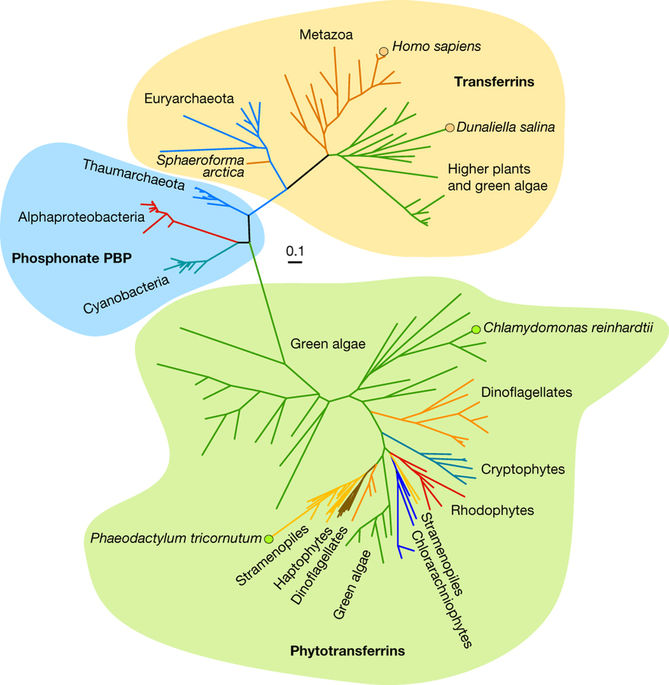Our official English website, www.x-mol.net, welcomes your
feedback! (Note: you will need to create a separate account there.)
Carbonate-sensitive phytotransferrin controls high-affinity iron uptake in diatoms
Nature ( IF 50.5 ) Pub Date : 2018-03-01 , DOI: 10.1038/nature25982 Jeffrey B. McQuaid , Adam B. Kustka , Miroslav Oborník , Aleš Horák , John P. McCrow , Bogumil J. Karas , Hong Zheng , Theodor Kindeberg , Andreas J. Andersson , Katherine A. Barbeau , Andrew E. Allen
Nature ( IF 50.5 ) Pub Date : 2018-03-01 , DOI: 10.1038/nature25982 Jeffrey B. McQuaid , Adam B. Kustka , Miroslav Oborník , Aleš Horák , John P. McCrow , Bogumil J. Karas , Hong Zheng , Theodor Kindeberg , Andreas J. Andersson , Katherine A. Barbeau , Andrew E. Allen

|
In vast areas of the ocean, the scarcity of iron controls the growth and productivity of phytoplankton. Although most dissolved iron in the marine environment is complexed with organic molecules, picomolar amounts of labile inorganic iron species (labile iron) are maintained within the euphotic zone and serve as an important source of iron for eukaryotic phytoplankton and particularly for diatoms. Genome-enabled studies of labile iron utilization by diatoms have previously revealed novel iron-responsive transcripts, including the ferric iron-concentrating protein ISIP2A, but the mechanism behind the acquisition of picomolar labile iron remains unknown. Here we show that ISIP2A is a phytotransferrin that independently and convergently evolved carbonate ion-coordinated ferric iron binding. Deletion of ISIP2A disrupts high-affinity iron uptake in the diatom Phaeodactylum tricornutum, and uptake is restored by complementation with human transferrin. ISIP2A is internalized by endocytosis, and manipulation of the seawater carbonic acid system reveals a second-order dependence on the concentrations of labile iron and carbonate ions. In P. tricornutum, the synergistic interaction of labile iron and carbonate ions occurs at environmentally relevant concentrations, revealing that carbonate availability co-limits iron uptake. Phytotransferrin sequences have a broad taxonomic distribution and are abundant in marine environmental genomic datasets, suggesting that acidification-driven declines in the concentration of seawater carbonate ions will have a negative effect on this globally important eukaryotic iron acquisition mechanism.
中文翻译:

碳酸盐敏感性植物转铁蛋白控制硅藻中的高亲和力铁吸收
在海洋的广大地区,铁的缺乏控制着浮游植物的生长和生产力。尽管海洋环境中的大多数溶解铁与有机分子复合,但皮摩尔量的不稳定无机铁物质(不稳定铁)维持在透光区内,是真核浮游植物特别是硅藻铁的重要来源。硅藻对不稳定铁利用的基因组研究先前已经揭示了新的铁响应转录物,包括三价铁浓缩蛋白 ISIP2A,但获得皮摩尔不稳定铁的机制仍然未知。在这里,我们表明 ISIP2A 是一种植物转铁蛋白,它独立地和会聚地进化出碳酸根离子配位的三价铁结合。ISIP2A 的缺失会破坏三角褐指藻中的高亲和力铁摄取,并且通过与人转铁蛋白的互补来恢复摄取。ISIP2A 通过内吞作用被内化,对海水碳酸系统的操纵揭示了对不稳定铁离子和碳酸根离子浓度的二级依赖性。在 P. tricornutum 中,不稳定的铁离子和碳酸根离子的协同相互作用发生在与环境相关的浓度下,这表明碳酸盐的可用性共同限制了铁的吸收。植物转铁蛋白序列具有广泛的分类学分布,并且在海洋环境基因组数据集中丰富,这表明酸化驱动的海水碳酸根离子浓度下降将对这种全球重要的真核生物铁获取机制产生负面影响。
更新日期:2018-03-01
中文翻译:

碳酸盐敏感性植物转铁蛋白控制硅藻中的高亲和力铁吸收
在海洋的广大地区,铁的缺乏控制着浮游植物的生长和生产力。尽管海洋环境中的大多数溶解铁与有机分子复合,但皮摩尔量的不稳定无机铁物质(不稳定铁)维持在透光区内,是真核浮游植物特别是硅藻铁的重要来源。硅藻对不稳定铁利用的基因组研究先前已经揭示了新的铁响应转录物,包括三价铁浓缩蛋白 ISIP2A,但获得皮摩尔不稳定铁的机制仍然未知。在这里,我们表明 ISIP2A 是一种植物转铁蛋白,它独立地和会聚地进化出碳酸根离子配位的三价铁结合。ISIP2A 的缺失会破坏三角褐指藻中的高亲和力铁摄取,并且通过与人转铁蛋白的互补来恢复摄取。ISIP2A 通过内吞作用被内化,对海水碳酸系统的操纵揭示了对不稳定铁离子和碳酸根离子浓度的二级依赖性。在 P. tricornutum 中,不稳定的铁离子和碳酸根离子的协同相互作用发生在与环境相关的浓度下,这表明碳酸盐的可用性共同限制了铁的吸收。植物转铁蛋白序列具有广泛的分类学分布,并且在海洋环境基因组数据集中丰富,这表明酸化驱动的海水碳酸根离子浓度下降将对这种全球重要的真核生物铁获取机制产生负面影响。









































 京公网安备 11010802027423号
京公网安备 11010802027423号